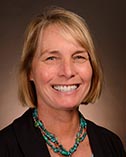
Janet Franklin
San Diego State University
|
Primary Section: 64, Human Environmental Sciences Secondary Section: 63, Environmental Sciences and Ecology Membership Type:
Member
(elected 2014)
|
Biosketch
Janet Franklin is a Distinguished Professor in the Department of Botany and Plant Sciences, University of California - Riverside. She is a biogeographer and landscape ecologist who uses geospatial data and spatial analytical tools to study the past, present and future distributions of biodiversity in relation to the physical environment, ecological processes and human impacts. Franklin was born in Frankfurt, Germany in 1959 and grew up near San Francisco. She graduated from University of California, Santa Barbara with a BA in Environmental Biology (1979) and an MA (1983) and PhD (1988) in Geography. She was on previously the faculties of Geography and Biology at San Diego State University (1988-2009) the Schools of Life Sciences and of Geographical Sciences and Urban Planning at Arizona State University (2009-2017). She has been president of the U.S. chapter of the International Association of Landscape Ecology (2014-2016). She a a Fellow of the American Association for the Advancement of Science, the American Academy of Arts and Sciences, and the Ecological Society of America. She is an Associate Member, Centre for Coastal Paleoscience, Nelson Mandela University, South Africa.
Research Interests
Janet Franklin studies the patterns and dynamics of terrestrial plant communities at the landscape scale. Plant communities are important elements of regional biodiversity and provide essential habitat for individual species. She has done field work in California, the American Southwest, West Africa, South Africa, the Pacific Islands, and the Caribbean. As a geographer her work often focuses on describing spatial patterns and inferring underlying pattern-generating processes via simulation modeling, natural and designed experiments, and other approaches. She is recognized for her expertise in species distribution modeling, a methodology that associates observations of a biotic response variable such as species occurrence with environmental predictors, resulting in a spatial prediction of habitat suitability. Her research addresses the impacts of natural disturbance and human-caused landscape change on ecosystems and biodiversity, and has provided insights about synergistic impacts of global change factors on biodiversity. Land use change, altered disturbance regimes, climate change, and invasive species operate at the scale of landscapes and regions, leading to ecosystem change, habitat loss and species decline. Only by considering these factors together can it be determined which factors may amplify effects of others (for example urban growth and climate change), and where.

